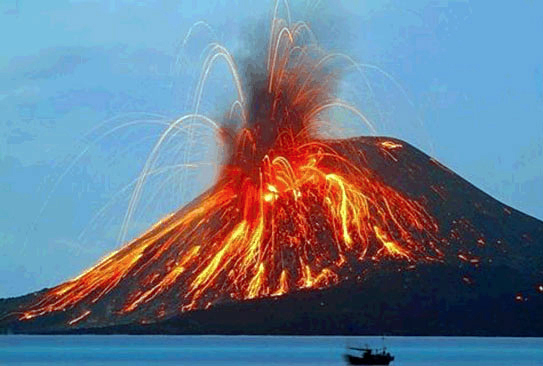If people are asked to name the volcanos of Italy, most will immediately answer Vesuvius. After a moment or so, some will also answer Etna. But it was Italy’s lesser known major volcano, Mount Stromboli that gained the spotlight last week with a major eruption. The volcano has been in almost continuous eruption for the past 2,000 years. Normally this pattern is maintained at the summit craters, with mild to moderate eruptions occurring at intervals ranging from minutes to hours. The activity last week was anything but normal. Frightened tourists fled as the volcano erupted, hurling burning rocks which killed a 35-year-old hiker from Sicily. The significant event, known to the Vulcan world as a Strombolian explosion, rocked the ground, leaving lava to spew from all of the active mouths around the crater. It sent an ominous mushroom cloud tens of thousands of feet into the atmosphere. Around 30 tourists leaped into the sea for safety and 1,000 in all were evacuated. Areas in the crater also suffered a major collapse as a result of the explosion, which ejected more material in seconds than the total that had been released over the course of the past five years.
The latest eruption of Stromboli was a deadly reminder that Italy is one of the few countries in Europe with active volcanoes. Italy spans two tectonic plates: the Eurasian Plate and the African Plate, which meet between Sicily and the mainland. At the boundary between the two, one is forced under the other and sinks into the Earth’s hot mantle. The water within it is being squeezed out at a high pressure, helping to form magma deep underground that forces its way to the surface and bursts through in the form of a volcano.
The area has three main hotspots: a chain of volcanoes in and around the Bay of Naples in Campania; another cluster in north-east Sicily and a third near Pantelleria, the island between Sicily and Tunisia. While most of its volcanoes have been dormant for at least 100 years, three remain active: Stromboli on its own island off northern Sicily, Etna, in northeast Sicily and Vesuvius in the Bay of Naples.
Alone on its sparsely populated island, Stromboli is the smallest, but the most active, erupting almost continuously for most of the past 2,000 years, though usually much less dramatically. Geologists have coined a term, Strombolian, to describe the distinctive type of eruption with which the volcano is associated – a series of mild but spectacular bursts that send molten rock and ash shooting a thousand feet or more into the air. Last week’s explosion was the first deadly eruption in several decades, after one hiker was killed. In 2002, an eruption resulted in several hospitalizations and created a damaging tsunami, but did not result in any deaths.
Etna is also in near continuous eruption, but has a far deadlier record: at least 77 deaths can be attributed to its eruptions over the centuries, but some records claim that the total is in the thousands. The toll is partly due to Etna’s size – at roughly 11,000 feet in height, it is more than twice that of Italy’s second largest volcano, Vesuvius. It is also partly due to its proximity to populated areas. For centuries, people have been drawn to the mountain for the rich volcanic soil on its slopes, which supports abundant vines, crops and fruit trees.
Etna’s most destructive eruption on record took place in 1669, when lava swept through villages on the mountainous slope, continuing all the way to Catania on the coast. Defensive walls protected the city and sent molten rock plunging into the harbor.
Major eruptions have taken place roughly twice a decade for the past half century, but Etna’s eruptions cause no damage, sometimes forcing authorities to close Catania airport and its airspace because of the vast clouds of ash.
While Etna and Stromboli are almost constantly rumbling, Vesuvius has maintained its silence since 1944, when its last major eruption destroyed several villages and damaged a nearby U.S. air base. The only volcano on Italy’s mainland, its eruptions are always dramatic. Most famously, the eruption of 79 AD wiped out the population of Pompeii, but an eruption in 1631 buried villages in lava and killed about 3,000 people.
Most do not realize that Vesuvius forced the cancellation of an Olympics in Italy. In 1906, the volcano erupted two years before Rome was due to host the Summer Games, forcing the government to put the funds for the Games into rebuilding Naples. Organizers had to look for an alternative venue and London was selected. The biggest risk factor is how close Vesuvius lies to Naples, Italy’s third biggest city. The Italian authorities monitor the volcano’s activity closely and have drawn up plans for evacuation if the signs point to an eruption.
As well as its three active volcanoes, Italy is also home to several others that lie dormant. Of special mention is Vulcano, from which the name volcano is derived. It is a small volcanic island in the Tyrrhenian Sea, about 16 miles north of Sicily and located at the southernmost end of the eight Aeolian Islands. The island rises to 1,644 feet above sea level, but since it last erupted over a century ago in 1888, it is classified as dormant.
Other inactive volcanos include Ischia, the island off Naples that last saw an eruption in 1302; Larderello in Tuscany, dormant since 1282, now a major source of geothermal power and a string of volcanoes near Rome that gave the region its beautiful volcanic lakes: Albano, Bracciano and Nemi.
Also of note is Empedocles, an underwater volcano off Sicily that created a new island in 1831 and started a scramble as European powers rushed to claim it. The British got there first and named it Graham Island, only for France and Sicily to stake rival claims. The conflict was resolved when the island sank back beneath the waters later the same year, never to surface again. It has since risen among signs of fresh volcanic activity, but currently lies 25 feet below sea level.





